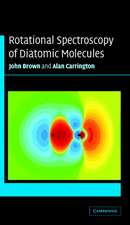Essential Computational Modeling in Chemistry
Autor Philippe G. Ciarleten Limba Engleză Paperback – 6 dec 2010
Computational Modeling is an active field of scientific computing at the crossroads between Physics, Chemistry, Applied Mathematics and Computer Science. Sophisticated mathematical models are increasingly complex and extensive computer simulations are on the rise. Numerical Analysis and scientific software have emerged as essential steps for validating mathematical models and simulations based on these models. This guide provides a quick reference of computational methods for use in understanding chemical reactions and how to control them. By demonstrating various computational methods in research, scientists can predict such things as molecular properties. The reference offers a number of techniques and the numerical analysis needed to perform rigorously founded computations.
Various viewpoints of methods and applications are available for researchers to chose and experiment with; Numerical analysis and open problems is useful for experimentation; Most commonly used models and techniques for the molecular case is quickly accessible
Preț: 362.97 lei
Preț vechi: 394.54 lei
-8% Nou
Puncte Express: 544
Preț estimativ în valută:
69.45€ • 72.71$ • 57.47£
69.45€ • 72.71$ • 57.47£
Carte tipărită la comandă
Livrare economică 29 martie-12 aprilie
Preluare comenzi: 021 569.72.76
Specificații
ISBN-13: 9780444537546
ISBN-10: 0444537546
Pagini: 400
Ilustrații: 1 illustrations (1 in full color)
Dimensiuni: 165 x 240 x 20 mm
Greutate: 0.62 kg
Editura: ELSEVIER SCIENCE
ISBN-10: 0444537546
Pagini: 400
Ilustrații: 1 illustrations (1 in full color)
Dimensiuni: 165 x 240 x 20 mm
Greutate: 0.62 kg
Editura: ELSEVIER SCIENCE
Public țintă
Scientists, Engineers, Computational Biologists, Medical Researchers, Computational Physicists, Biophysicists, Bioinformatics Specialists, Computational Chemists and other Biological or Behavioral Science Researchers who need to understand numerical techniques for various systems and applications.Cuprins
1. The modeling and simulation of the liquid phase;
2. Computational approaches of relativistic models in quantum chemistry;
3. Quantum Monte Carlo methods for the solution of the Schrödinger equation for molecular systems;
4. Finite difference methods for ab initio electronic structure and quantum transport calculations of nanostructures;
5. Simulating chemical reactions in complex systems;
6. Biomolecular conformations can be identified as metastable sets of molecular dynamics;
7. Numerical methods for molecular time-dependent schrödinger equations — bridging the perturbative to nonperturbative regime;
8. Control of quantum dynamics: Concepts, procedures and future prospects;
2. Computational approaches of relativistic models in quantum chemistry;
3. Quantum Monte Carlo methods for the solution of the Schrödinger equation for molecular systems;
4. Finite difference methods for ab initio electronic structure and quantum transport calculations of nanostructures;
5. Simulating chemical reactions in complex systems;
6. Biomolecular conformations can be identified as metastable sets of molecular dynamics;
7. Numerical methods for molecular time-dependent schrödinger equations — bridging the perturbative to nonperturbative regime;
8. Control of quantum dynamics: Concepts, procedures and future prospects;










